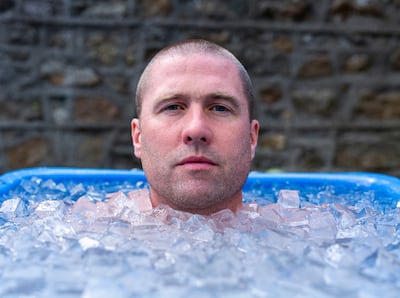Long used by professional footballers and other elite sports people to aid recovery from injuries, so-called cold therapy has become a popular wellness trend.
At a recent Fáilte Ireland event on Portmarnock Beach, Co Dublin, Wim Hof-trained cold-therapy advocate Níall Ó Murchú explained how, when combined with breathwork, cold water therapy – ice baths, cold showers and sea or lake swimming – offers many mental and physical health benefits.
“Cold water has scientifically proven benefits like boosting our immunity and reducing inflammation and pain but when combined with breathwork, it can also reduce stress and leave you feeling calm and in control,” says Ó Murchú. Exposure to the cold water has also been found to release endorphins, the brain hormones that elevate your mood.
Dutch-born Hof – also known as The Iceman – has gained worldwide fame for his promotion of the health benefits of cold therapy, as well as his ability to carry out extreme body experiments such as standing in a container filled with ice cubes or running a half marathon barefoot in the snow.
Studies at Wayne State University in Michigan and Radboud University in the Netherlands found that when Hof was put in a special temperature-controlled suit and placed in a functional MRI and a PET scanner, brain activity associated with pain suppression, self-reflection and wellbeing were activated. Ongoing studies are measuring the impact of the so-called Wim Hof Method (which promotes a disciplined approach to mastering conscious breathing and cold exposure together) on mental health and stress resilience and pain perception.
Ó Murchú says combining exposure to cold – whether in cold showers, ice baths or through cold water swimming – with breathing techniques is key. “When you have your breath settled and under control, it’s time to get out. If you stay beyond that peak state, you will start to get cold,” he says.
Before our group ventured out on to Portmarnock Strand (on what turned out to be an un-seasonally mild October day), Ó Murchú took us through a series of breathing exercises to give us a sense of calm and control when getting into the cold waters of the Irish Sea.
“Your breath is your constant companion and you can change your breathing in any moment and by doing so, you change how you feel,” says Ó Murchú, echoing the principles of yoga breath-work and relaxation/meditation techniques. To control our fight-or-flight response to immersion in cold water, Ó Murchú advises us to give our full attention to the in breath followed by a long out breath, staying with it until the end of the exhalation.
And once out of the water, it’s apparently vital that you allow your body warm itself up naturally before you hop into a hot shower or go into a sauna (of which more later). “It’s important to warm up from the inside out,” says Ó Murchú, as he teaches us the so-called horse stance practice. With legs wide and knees slight bent, we punch the air with long arms and fists slightly turned to the side. Doing this slowly at first and then faster and faster brings heat and energy back into the body. The practice ends with stretched-out arms raised above our heads and then lowered during a big breath in and out.
Speaking about the growing trend of saunas close to sea swimming spots, Ó Murchú says that it is important to let your body regulate its own temperature for a few minutes before moving from the sea to the sauna. The optimum is to do a couple of minutes of cold water, 15 minutes of sauna, another couple of minutes of cold therapy and 15 more minutes of sauna. “But people need to transition for three or four minutes from the cold before they go into the extreme heat of a sauna,” he cautions.
There are lots of other ways that people can experiment with cold water therapy, including simply finishing off washing your hands with cold water, walking barefoot in your garden, on a patio or even on a cold floor and changing the water temperature from warm to cold for a short time before you get out of the shower. Quoting Dr Susanna Soberg – the Danish author of Winter Swimming: The Nordic way towards a healthier and happier life – he says we need to accumulate about 11 minutes of cold therapy a week.

In his book, The Power of Cold, Ó Murchú speaks about his own introduction to cold therapy, first through cold showers and then winter sea swimming after years of pursuing natural approaches to health including yoga, herbal medicine and meditation. “I heard Wim Hof talk on a podcast at a difficult time in my life with four young children and a lot of experience of grief following deaths of loved ones.
“Hof connected the cold with breathing and although I had grown up swimming in the sea in Portmarnock, I had never brought the two together into an experience that could help.”
Now, he spends some time every day doing breathing exercises and cold therapy. “There is a sense of adventure about the cold but the breath is the secret weapon. The benefits are unbelievable even if you don’t know any of the science.”
He does, however, advise everyone to listen to their bodies – and to be aware of warning signs of their body getting too cold. “We have pulled people back from hypothermia with the horse stance and it’s very important that people listen to their own bodies and their breathing.”
Prof Rose Anne Kenny, a geriatrician in St James’s Hospital and an advocate of cold water therapy says there are three groups of people who need to be cautious about embarking on it. “Anyone with cardiac disease needs their GP to advise them on whether they are safe to do it or not because cold water can further shut down blood supply to the heart,” she explains.
There is a condition called transient global amnesia which, although not common, can affect some people getting into cold water for the first time. “It’s a loss of memory and disorientation after the experience of cold water. It’s a benign condition which passes but you need to gradually expose yourself to cold water again if this happens and have it checked out by your GP,” she advises.
The third group are people who suffer from Raynaud’s Syndrome, which is when the blood vessels in the peripheral areas go into a temporary spasm, blocking the blood flow and causing painful hands and feet following exposure to cold water. “It’s not dangerous but it’s painful and very common,” she explains. Wearing gloves and rubber shoes when in the water can help people who suffer from Raynaud’s Syndrome.
[ Could bathing in cold water reduce anxiety and stress?Opens in new window ]
Ó Murchú runs retreats and workshops with ice baths throughout Ireland. He credits his wife Josie as the “deep organising force behind it all”.
“I also teach companies how to breathe to deal with stress,” he says. “Breathing is always some part of the solution no matter what you are dealing with. When we are under pressure, we are pushed out of feeling ourselves. Breathing brings us back to a place where we feel ourselves.”










